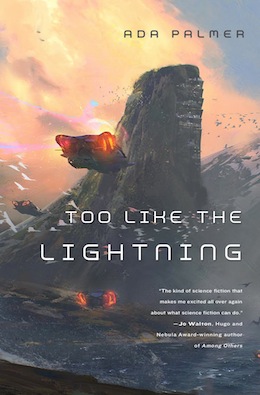When it comes to outlining vs. improvising, I’ve found that we all do the same steps in a different order.
Many writing conversations (whether on panels, in blog posts, etc.) discuss a plotter vs. pantser binary, plotters being outliners, authors who plan work thoroughly before beginning, while the pantser, from the expression “fly by the seat of your pants” plunges into writing the beginning without a plan. I myself am certainly the plotter archetype, producing reams of notes, spreadsheets, and outlining a whole series before beginning Chapter 1, but the more I talk with friends who fit the pantser archetype, the clearer it becomes that the two methods are not as different as they’re made to seem. The real difference is not what we do, but what order we do it in, which steps we do before, which during, and which after drafting the text.
I’ll describe my own process briefly to get some vocabulary down. I start with a long process of world building, with character creation as a part of it, in which nifty concepts and ideas for people shaped by them appear and connect together, forming a world and its tensions. Along this will develop a sense of mood or emotion, and the overall long stages of a story (mystery, then tragedy, then crisis, then hope, or crisis first, then mystery, then hope, then tragedy, etc.). Once the world and characters are developed enough for me to have a sense of conflicts that can arise, or changes or choices the characters could face, I sit down to outline, starting by writing down the few big moments that I know have to come, and working out their necessary order (ABC discovery is made, character X meets character Y, the conflict between D and F turns to violence, the reader learns about G, etc.).
Noting each big moment down as a paragraph with gaps between, I then fill in the additional chapters that need to happen before and after each major turning point. Often some events need to happen between certain other events in the story in order for them to work (i.e. we need to meet Tiny Tim before the Ghost of Christmas Future foretells his fate) while other times there is flexibility about the order (do we hear the creator of Jurassic Park describe his touching backstory before or after we see the villain’s death?). I spend a while fitting all the necessary chapters into order, often moving flexible ones around, thinking through how the reader experience would be different if we change the order (i.e. should we get to hear Juliet talking alone on her balcony before Romeo addresses her, so we already know their love is mutual, or should he instead address her before she speaks, so we don’t yet know if she loves him or not?). As I play with the order of chapters, I think through a number of elements of pacing including:
- pace of revelation (making sure too many details or revelations aren’t all in a pile at once)
- knowledge and reminders (the reader must know Fact X before the chapter that depends on it, and if Fact X was introduced too long before then the reader may need a reminder)
- individual character arcs (how often particular characters appear, to make sure we don’t get all of Character X’s appearances in a row and none in ¾ of the book, unless that’s intentional)
- thematic arcs (making sure there are several chapters where a theme like Providence or custodianship is important before the key chapter where that theme comes to a climax)
- emotional arc (making sure tense and distressing chapters have restful or cathartic ones in between to give the reader a break).
- subdivision (do these all need to be separate chapters? can some merge?)
Once everything is in order and looks workable, I reread my outline several times, imagining on each pass that I’m a reader invested in a particular favorite character, faction, side, theme etc., and make sure it all makes sense and feels satisfying at the end. Time then to write paragraph one.
This outlining process usually takes me about six months.
Now, let’s look at the so-called pantser.
When I talk to friends who start writing without an outline, they often describe having partial plans in mind at the start. Many describe not just having some characters and world building complete, but having a sense of certain key events that are coming (a crisis at the middle, a revelation at the 2/3 mark, a tragedy at 3/4, knowing what the ending must be like). Often writers describe it with a metaphor: the shape of the story, the key beats of the story, the arc of the story, the movements of the story like a symphony, the story as a wiggly line rising and falling. Such friends describe writing toward the next key moment in this shape/rhythm/arc, thinking Can I write X event yet? No, first Character-F needs to arrive, and the reader needs to learn what K is. This is exactly the same thing I do when I start my outline, writing down the few big moments I know have to come, and then filling in the additional chapters that need to come in between.
Often such friends discuss coming to a point and realizing they needed another chapter earlier, or need to rearrange chapters—this is exactly the same thing I do when I’m moving around the order of potential scenes and chapters in my outline, testing them out before and after the big beats.
These friends also describe the common experience of coming to the end of a draft or section and reading over it, realizing that the pacing is too tight, or a character needed to be introduced earlier, or needing to go back to insert the creation of X which is necessary later to solve problem Y—this is exactly what I do when I’m rereading my list of chapters thinking about whether the character arcs, emotional arc and such.
Buy the Book


Too Like the Lightning
We’re doing the same steps, just in a different order, and if friends who don’t outline often say they take months tweaking, and pausing in the middle to rethink a section, or going back and adding details at the end etc., I take months making the outline, so it even adds up to the same amount of time.
I also talk to friends who plan even less before beginning, who jump into writing Chapter 1 without a sense of beats, or world, or characters, just meandering along, but even in this case when I talk to them about how they develop the world as they go, how the characters they invent develop, the things they describe are exactly the experiences I have while doing my world building before starting my outline. And they too describe steps like coming to a chapter and thinking about what needs to be set up next, jumping back to add foreshadowing, or writing (“by instinct”) a tranquil, healing chapter, feeling that a more intense one will come next. Same things once again, just different order.
I think it’s important to attack the plotter v. pantser binary because I often hear people express a sense that plotting is somehow better, smarter, cleverer; that writing pantser-style is somehow sloppy or more amateur. The attitude is often that, if we have a river to cross, pantsers are people who just dive in and swim while plotters are clever enough to build a boat—when I described it that way to Jo Walton and Ken Liu (both pantsers by the binary) both laughed and agreed that’s what it often feels like. But it isn’t that I build a boat and they don’t, it’s that I build the whole boat first, while they assemble just enough boards to make the hull and hop on, carrying a pack of planks with them, assembling the rest of the boat during the process of crossing the river. That’s pretty clever too!
It isn’t just that both methods get across the river in the end—we really do all the same boat-building steps as well, just at different stages, some of us imagining a reading experience while it’s still in outline form, others writing it out and feeling out the pacing, arcs, themes, revelations etc. as they go. Both work, and so do various hybrid methods that people use—and it seems more useful to note that we’re all doing the same things in a different order than to value one order of operations more highly than the other.
Ada Palmer is a historian, working primarily on the Renaissance, Italy, censorship, radical thought, science, books and printing, as well as manga and anime. She writes the blog ExUrbe.com, does the Ex Urbe Ad Astra podcast with Jo Walton discussing the craft of writing, and composes SF & Mythology-themed music for the a cappella group Sassafrass. The novels of her Terra Ignota quadrilogy—Too Like the Lightning, Seven Surrenders, The Will to Battle , and Perhaps the Stars—are available from Tor Books.










